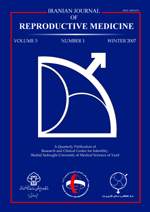
|
International Journal of Reproductive BioMedicine
Research and Clinical Center for Infertility, Shahid Sadoughi University of Medical Sciences of Yazd
ISSN: 1680-6433
EISSN: 1680-6433
Vol. 13, No. 8, 2015, pp. 495-502
|
 Bioline Code: rm15066
Bioline Code: rm15066
Full paper language: English
Document type: Research Article
Document available free of charge
|
|
|
International Journal of Reproductive BioMedicine, Vol. 13, No. 8, 2015, pp. 495-502
| en |
Sperm parameters, protamine deficiency, and apoptosis in total globozoospermia
Ghasemzadeh, Jalal; Talebi, Ali Reza; Khalili, Mohammad Ali; Fesahat, Farzaneh; Halvaei, Iman; Nabi, Ali & Ashourzadeh, Sareh
Abstract
Background: Globozoospermia is a severe form of teratozoospermia (incidence < 0.1%) in infertile men that is characterized by round headed sperm and acrosomeless in semen.
Objective: To compare the semen parameters, protamine deficiency, and apoptosis in ejaculated spermatozoa between globozoospermic and normozoospermic men.
Materials and Methods: Thirty six semen samples were divided into two groups
including 15 infertile men with total globozoospermic (> 90% round-headed sperm)
and 21 healthy donors with normal spermograms as controls. Semen analysis was
performed according to World Health Organization criteria (2010). Sperm protamine
deficiency was assessed using Chromomycin A3 (CMA3) staining and the rate of
apoptotic spermatozoa was evaluated with TUNEL assay.
Results: Sperm concentration, motility, and normal morphology in globozoospermic
men were significantly decreased compared with controls (p<0.05). The rate of
CMA3-reacted spermatozoa (CMA3+) in globozoospermic men was higher than
controls (65.93 ± 11.77 vs. 21.24 ± 7.37, respectively, p<0.0001). The rate of
apoptotic spermatozoa (TUNEL positive) were significantly increased in
globozoospermic cases with respect to the controls (17.60 ± 10.72 and 5.95 ± 3.02,
respectively, p<0.0001). There was no significant correlation between sperm
protamine deficiency and apoptosis in globozoospermic men.
Conclusion: Globozoospermic samples contain a higher proportion of spermatozoa with abnormal chromatin packaging and DNA fragmentation than normozoospermic samples. Therefore, in addition to absence of acrosome in the spermatozoa of globozoospermic patients, the high percentage of spermatozoa with immature chromatin and apoptotic marker may be considered as the other etiologies of infertility in these patients.
Keywords
Male infertility; DNA damage; Sperm protamine; Apoptosis
|
| |
© Copyright 2015 - Iranian Journal of Reproductive Medicine
Alternative site location: http://www.ijrm.ir
|
|
